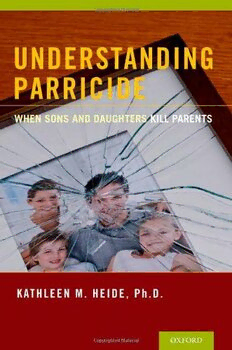Table Of ContentUnderstanding
Parricide
This page intentionally left blank
UNDERSTANDING
PARRICIDE
WHEN SONS AND
DAUGHTERS KILL
PARENTS
Kathleen M. Heide , Ph.D.
1
1
Oxford University Press is a department of the University of Oxford. It furthers the University’s
objective of excellence in research, scholarship, and education by publishing worldwide.
Oxford New York
Auckland Cape Town Dar es Salaam Hong Kong Karachi
Kuala Lumpur Madrid Melbourne Mexico City Nairobi
New Delhi Shanghai Taipei Toronto
With offi ces in
Argentina Austria Brazil Chile Czech Republic France Greece
Guatemala Hungary Italy Japan Poland Portugal Singapore
South Korea Switzerland Thailand Turkey Ukraine Vietnam
Oxford is a registered trade mark of Oxford University Press in the UK and certain other
countries.
Published in the United States of America by
Oxford University Press
198 Madison Avenue, New York, NY 10016
© Kathleen Margaret Heide 2013
All rights reserved. No part of this publication may be reproduced, stored in a retrieval system,
or transmitted, in any form or by any means, without the prior permission in writing of Oxford
University Press, or as expressly permitted by law, by license, or under terms agreed with the
appropriate reproduction rights organization. Inquiries concerning reproduction outside
the scope of the above should be sent to the Rights Department, Oxford University Press,
at the address above.
You must not circulate this work in any other form
and you must impose this same condition on any acquirer.
Library of Congress Cataloging-in-Publication Data
Heide, Kathleen M.
Understanding parricide: When sons and daughters kill parents / Kathleen M. Heide, Ph.D.
p. cm.
Includes bibliographical references and index.
ISBN 978–0–19–517666–7 (pbk)
1. Parricide. 2. Family violence. 3. Abused children. 4. Mentally ill children – Treatment.
5. Juvenile homicide. 6. Parricide. – Case studies. 7. Family violence – Case studies.
8. Abused children – Case studies. 9. Mentally ill children – Treatment – Case studies.
10. Juvenile homicide – Case studies. I. Title.
HV6542.H449 2013
364.152’3 – dc23 2012014179
9 8 7 6 5 4 3 2 1
Printed in the United States of America on acid-free paper
To Eldra P. Solomon
and Fran Knowles
with deep appreciation
for your friendship,
support, and encouragement
over the decades.
This page intentionally left blank
Contents
Foreword by Dr. George B. Palermo ix
Preface xiii
Acknowledgments xvii
Part One: Clinical and Legal Issues
1. The Phenomenon of Parricide 3
2. Child Maltreatment and Parricide 27
3. Parricide: Basic Facts and Literature 47
4. Matricide: Basic Facts and Literature 75
5. Patricide: Basic Facts and Literature 103
6. Prosecuting and Punishing Parricide Offenders 123
7. Defending Parricide Offenders 139
Part Two: Case Studies
8. Forensic Assessment of Parricide Offenders 169
9. Patty Smith—No Way Out but Murder 181
10. Peter Jones—Repeating the Past 205
11. James Holt—The Making of a Murderer 227
12. Daniel Culbreath—Fantasy Becomes Reality 257
13. Ben Simpson—An Over-Indulged Child 289
Part Three: Society’s Response
14. Treating Severely Abused Parricide Offenders 317
with Eldra Solomon, Ph.D.
15. Follow-Up Studies of Adolescent Parricide Offenders 331
16. Risk Assessment and Prevention 355
Afterword by Judge Irene Sullivan 371
Notes 375
References 409
Index 437
About the Author 445
This page intentionally left blank
Foreword
Socio-cultural taboos have had the function of keeping human aggressive and
destructive drives in check since the beginning of civilization. Nevertheless, history
is replete with acts of violence, including that which is the topic of this book, par-
ricide. At present, such intra-familial violence, frequently fueled by terror or des-
peration in adolescent parricide offenders and often by feelings of humiliation and
frustration in adult parricide offenders, might erupt in families that have become
destabilized in a climate of progressive social change. In Understanding Parricide:
When Sons and Daughters Kill Parents , Professor Kathleen Heide, in her usual objec-
tive and methodical way, describes the consequences of this climate within the
family as she sheds light on the incomprehensible killing of parents by their chil-
dren, the tragic shattering of a multi-millenial taboo and Biblical commandments.
Even though she addresses both juvenile and adult parricide, her emphasis is on
juvenile offenders, as their destructive behavior is more amenable to prevention and
treatment.
Throughout the 16 chapters of this highly comprehensive book, Dr. Heide exam-
ines in a progressive way the problematic entity of parricide. The fi rst chapter is
fundamental to the understanding of parricidal offenders. Maltreatment and abuse,
from emotional neglect to rape, are dealt with in Chapter 2. Their psychobiological
consequences on the child/adolescent are pointed out in a concise and thorough
way.
In the next several chapters, Professor Heide introduces psychological, biological,
social, and legal views, especially when discussing the dangerously antisocial parricide
offender and his or her characterological tendency toward violent behavior. She mas-
terfully discusses the motivational dynamics, the legal issues, and the relevant defense
strategies in various case studies. Her typology of adolescent and adult parricidal
offenders, proposed in her fi rst book, Why Kids Kill Parents, and validated throughout
20 years of professional and forensic experience, is highlighted in the extensive case
studies presented in Chapters 8 through 13. The illustrative cases show the importance
of a thorough assessment of the offender’s personality and its development over years
of maltreatment and abuse.
The various steps in the diagnostic process and the diagnostic criteria employed
by Dr. Heide when examining these young offenders are of particular interest. They
not only will captivate the interest of the studious reader, but also will enhance the
diagnostic and treatment choices of many mental health and legal professionals. In
addition, her clear and enlightening description of the various legal defense strategies
based upon the mental state of the offender and recent national court dispositions

